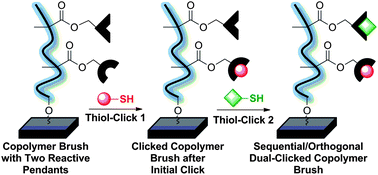Fabrication of multifunctional surfaces with complexity approaching that found in nature requires the application of a modular approach to surface engineering. We describe a versatile post-polymerization modification strategy to synthesize multifunctional polymer brush surfaces via combination of surface-initiated photopolymerization (SIP) and orthogonal thiol-click reactions. Specifically, we demonstrate two routes to multifunctional brush surfaces: in the first approach, alkyne-functionalized homopolymer brushes are modified with multiple thiolsvia a statistical, radical-mediated thiol-yne co-click reaction; and in the second approach, statistical copolymer brushes carrying two distinctly-addressable reactive moieties are sequentially modified via orthogonal base-catalyzed thiol-X (where X represents an isocyanate, epoxy, or α-bromoester) and radical-mediated thiol-yne reactions. In both cases, we show that surface properties, in the form of wettability, can be easily tuned over a wide range by judicious choice of brush composition and thiol functionality.

You have access to this article
 Please wait while we load your content...
Something went wrong. Try again?
Please wait while we load your content...
Something went wrong. Try again?


 Please wait while we load your content...
Please wait while we load your content...